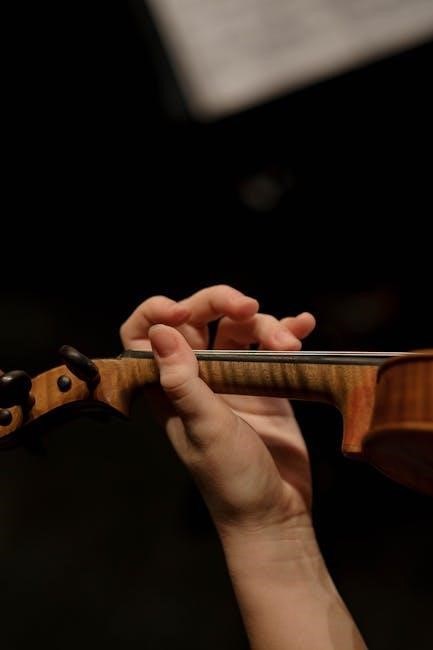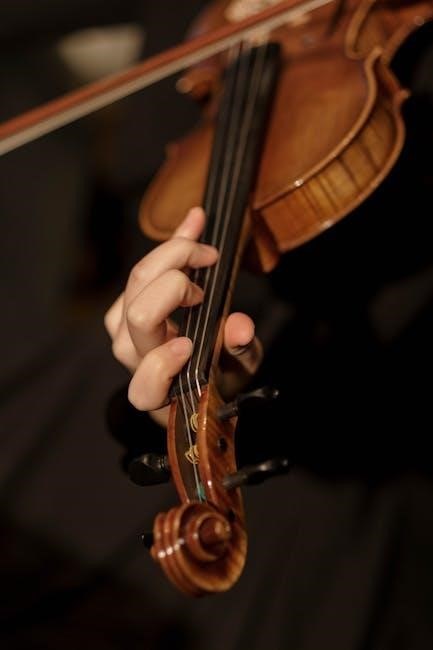violin fingering chart pdf
A violin fingering chart is a visual guide mapping notes on the fingerboard, showing which fingers to use for each note. Available as PDF downloads, these charts help students quickly locate notes, improve intonation, and enhance practice efficiency. They are essential tools for violinists of all skill levels, providing clarity and precision in mastering the instrument.
1.1 What is a Violin Fingering Chart?
A violin fingering chart is a detailed guide that maps the violin fingerboard, indicating the correct finger to use for each note. Typically available in PDF format, these charts provide a visual representation of the finger positions for every note, including open strings and enharmonics. They are designed to help violinists of all levels locate notes quickly, understand finger placement, and improve intonation. The charts often include note names, musical notation, and finger assignments, making them invaluable tools for practice and performance.
1.2 Importance of Fingering Charts for Violinists
Violin fingering charts are essential tools for improving intonation, technical accuracy, and overall musicianship. They provide clear visual guidance, helping violinists quickly locate notes and understand proper finger placement. These charts are particularly valuable for beginners, as they simplify the learning process and build muscle memory. For advanced players, they offer precise finger assignments for complex passages. By using fingering charts, violinists can enhance their practice efficiency and confidence, ensuring consistent and accurate performance across various musical contexts.
1.3 How to Use a Violin Fingering Chart
To effectively use a violin fingering chart, start by downloading and printing the PDF. Place it near your music stand for easy reference while practicing. Align the chart with your sheet music to identify corresponding notes and finger placements. Highlight or mark notes you struggle with for focused practice. Regularly review the chart to build familiarity with finger positions and improve intonation. Customize it by adding personal fingerings or notes for specific pieces, ensuring it becomes a tailored tool for your musical growth.

Understanding Violin Finger Placement
Understanding violin finger placement involves mastering where fingers press the strings on the fingerboard, starting with first position basics and open string usage to ensure proper intonation and technique.
2.1 First Position Fingering Basics
First position fingering is the foundation of violin technique, where the first finger is placed near the nut. Open strings are used as reference points, with each finger covering specific notes. Charts provide clear finger assignments, helping beginners learn proper placement and intonation. This position focuses on notes within one octave, ensuring a strong technical base. Regular practice with these fingerings improves accuracy and prepares for advanced positions. PDF charts offer a visual guide, making learning intuitive and accessible for students of all ages.
2.2 Advanced Positions (Up to 8th Position)
Advanced positions on the violin extend beyond first position, with the 8th position being a common upper limit. These positions require precise finger placement and are used for higher-pitched music. PDF charts for advanced players detail every note up to the 8th position, showing finger assignments for each string. These charts are invaluable for improving intonation and technical accuracy in complex passages. They also help violinists navigate the fingerboard with confidence, ensuring proper finger substitutions and alternate fingerings for musical expression. Regular practice with these charts enhances mastery of higher positions.
2.3 Open Strings and Their Roles
Open strings play a vital role in violin playing, serving as reference points for tuning and finger placement. They are indicated on fingering charts, often by rectangles, and are essential for developing proper intonation. Open strings (G, D, A, E) provide a foundation for beginners to learn note positions and intervals. They are also used in scales and arpeggios to build finger strength and accuracy. Understanding open strings is crucial for mastering higher positions and advanced techniques, as they help establish a clear auditory and visual guide for violinists.

Key Features of a Comprehensive Violin Fingering Chart
A comprehensive chart includes note names, corresponding fingers, and visual fingerboard layouts. It highlights open strings and enharmonics, providing clear, precise guidance for violinists to master notes across positions.
3.1 Note Names and Their Corresponding Fingers
A key feature of a violin fingering chart is the precise mapping of note names to specific fingers. Each note, from A to G, is paired with a recommended finger (1st to 4th) to ensure proper intonation and technique. This correspondence is clearly marked, often above the stave, making it easy for students to learn and memorize. The charts also account for enharmonics, such as E/F and G/Ab, providing clarity in challenging cases. This system helps build consistency and accuracy in playing across all octaves and positions.
3.2 Visual Layout of the Fingerboard
A comprehensive violin fingering chart visually organizes the fingerboard, clearly showing each string and position. Notes are precisely placed, often with color-coding or symbols to differentiate fingers (1st to 4th). Open strings are highlighted, and enharmonics are noted. The layout mirrors the actual fingerboard, making it intuitive for players to locate notes quickly. This visual representation aids in understanding finger placement and string relationships, helping violinists navigate the fingerboard with confidence and precision, regardless of their skill level or musical context.
3.3 Indication of Enharmonics
Violin fingering charts often include enharmonics, showing alternative note names (e.g., E♭/D♯) to help players understand pitch equivalency. These are crucial for accurate intonation and technical precision. Enharmonics are typically marked with additional symbols or notes, ensuring clarity in finger placement. For example, a chart might indicate both F and E♭ for the same pitch, guiding players to choose the appropriate finger based on musical context. This feature enhances the chart’s versatility and aids in mastering complex passages with confidence and accuracy.

Violin Fingering Charts for Different Skill Levels
Violin fingering charts are tailored for beginners, intermediate, and advanced players, offering adaptable guidance. They provide clear note placements and finger assignments, supporting skill progression effectively.
4.1 Charts for Beginners
Beginner-friendly violin fingering charts focus on the first position, clearly indicating open strings and finger placements for each note. These charts simplify learning by providing a visual guide to finger assignments, helping students develop proper technique and intonation. They often include note names, string indicators, and basic finger patterns, making it easier for newcomers to navigate the fingerboard. Available as downloadable PDFs, these charts are essential tools for building a strong foundation and ensuring accurate note placement from the start.
4.2 Charts for Intermediate Players
Intermediate violin fingering charts expand beyond the first position, covering higher positions up to the 8th. These charts detail finger placements for complex notes and alternative fingerings, aiding in advancing technical skills. They often include enharmonics and key-specific patterns, helping players navigate various musical contexts. Available as PDF downloads, these charts provide a comprehensive guide for refining finger technique, improving intonation, and exploring advanced repertoire with precision and confidence.
4.3 Advanced Violin Fingering Charts
Advanced violin fingering charts are designed for skilled players, offering detailed finger placements up to the 8th position and beyond. These charts include complex note patterns, chromatic fingerings, and alternate fingerings for musical expression. They often cover enharmonics and advanced techniques like finger substitution. Available in PDF formats, these charts serve as invaluable resources for perfecting intonation, exploring intricate passages, and mastering the violin’s upper range with precision and artistic nuance.

The Role of Key Signatures in Fingering
Key signatures significantly influence finger placement on the violin, guiding note selection and intonation accuracy. Sharp and flat keys present unique challenges, requiring tailored fingerings to maintain pitch clarity and musicality. Neutral keys offer straightforward fingerings, while complex keys demand advanced techniques and adaptability. Understanding key signatures enhances technical precision and expressive playing, making them essential for mastering violin fingering charts.
5.1 Sharp Key Signatures and Their Impact
Sharp key signatures, such as G, D, and A, require specific finger placements to maintain pitch accuracy. These keys often demand higher finger positions on the fingerboard, which can challenge intonation and dexterity. The fingering patterns for sharp keys differ significantly from neutral keys, necessitating precise finger substitutions to avoid misplayed notes. Understanding these patterns is crucial for technical accuracy and expressive playing, especially in complex musical pieces. Violinists must adapt their technique to the unique demands of sharp keys to achieve clarity and consistency in performance.
5.2 Flat Key Signatures and Their Impact
Flat key signatures, such as F, B♭, and E♭, alter finger placement by lowering pitches, requiring adjustments in finger positions and intonation. These keys often involve lower finger placements on the fingerboard, which can affect technical accuracy and tone quality. The fingering patterns for flat keys differ from sharp and neutral keys, necessitating careful finger substitutions to maintain proper pitch and clarity. Violinists must adapt their technique to the specific demands of flat keys to ensure smooth transitions and consistent intonation across the fingerboard.
5.3 Neutral Keys and Their Fingerings
Neutral keys, such as C major, have no sharps or flats, simplifying finger placement and intonation. These keys often use straightforward fingering patterns, minimizing finger substitutions. Neutral keys provide a foundational framework for learning, as they align closely with natural pitches on the fingerboard. Violinists can rely on consistent finger placements, making these keys ideal for building technique and muscle memory. Neutral keys also serve as a reference point for understanding more complex fingerings in sharp or flat keys, enhancing overall musical accuracy and expression.

Downloading and Printing Violin Fingering Charts
Violin fingering charts are widely available as PDF downloads from reputable music websites. They can be printed in high-quality formats for clear visibility and practical use, aiding violinists in mastering finger placements and note accuracy across the fingerboard.
6.1 Finding Reliable Sources for PDF Charts
Reputable websites like Fiddlermans, Music Store, and m5music.hk offer high-quality violin fingering charts in PDF format. These sources provide precise finger placements, note names, and string indicators, ensuring clarity for both beginners and advanced players. Many charts are free to download, making them accessible to all. When searching, look for websites with educational endorsements or reviews to ensure accuracy and reliability. Downloading from trusted sites guarantees that the charts are well-formatted and suitable for printing, aiding in effective practice and performance.
6.2 Printing Tips for Optimal Use
For optimal use, print violin fingering charts on high-quality paper or cardstock to ensure durability. Use actual size settings to maintain clarity and precise finger placement details. Choose a clear font size for readability, and consider laminating the charts for long-term use. Binding multiple pages together or storing them in a protective sleeve keeps them organized. Print in color if available, as it enhances visual cues. Ensure your printer is set to the correct paper size to avoid scaling issues. Keep the charts near your instrument or music stand for easy reference during practice.
6.3 Customizing Charts for Personal Use
Customizing violin fingering charts allows for personalized learning. Simplify layouts by highlighting relevant notes and fingerings, reducing clutter. Use color-coding to differentiate fingers or positions, aiding visual learners. Annotate charts with repertoire-specific marks or technical reminders. Adjust sizes to fit music stands or create foldable formats for convenience. Add notes on bow placement or intonation. Organize charts with bindings or tabs, and consider digitizing them for easy edits. Tailor the chart to enhance your practice efficiency and focus.

Benefits of Using a Violin Fingering Chart
Violin fingering charts offer numerous benefits, including improved intonation, enhanced technical accuracy, and the development of muscle memory, essential for all violinists.
7.1 Improving Intonation
Violin fingering charts are invaluable for improving intonation by providing clear visual guides to proper finger placements. By using these charts, students can quickly identify the correct notes and develop a stronger sense of pitch accuracy. The charts often highlight open strings and their roles, helping players understand tonal relationships. Regular practice with a fingering chart enhances the ability to produce clear, in-tune notes, which is essential for developing good technique and musical expression. This tool is particularly beneficial for beginners learning to navigate the fingerboard.
7.2 Enhancing Technical Accuracy
Violin fingering charts play a crucial role in enhancing technical accuracy by providing precise finger placements for each note. These charts map out the fingerboard, ensuring players use the correct fingers consistently. By following the chart, musicians can avoid finger placement errors, leading to clearer and more precise playing. This visual guide helps build muscle memory and improves dexterity, allowing for smoother transitions between notes. Regular use of fingering charts ensures that technical skills are developed accurately and efficiently, fostering overall musical proficiency.
7.3 Building Muscle Memory
Violin fingering charts are invaluable for building muscle memory, as they provide a consistent reference for finger placements. By repeatedly practicing notes with the correct fingers, players develop automaticity in their technique. The charts help in memorizing finger patterns, especially in different positions and key signatures. Over time, this repetition allows the fingers to recall placements instinctively, freeing the mind to focus on musical expression. Regular practice with a fingering chart accelerates this process, making complex passages feel natural and effortless.

Common Mistakes to Avoid When Using Fingering Charts
Overreliance on charts can hinder creativity, while ignoring musical context and failing to practice regularly limits progress. These mistakes can delay mastery of proper finger placement techniques.
8.1 Overreliance on Charts
Overreliance on violin fingering charts can hinder a player’s ability to develop musical intuition and creativity. While charts are invaluable for learning proper finger placements, they should not replace the development of ear training and technical skill. Relying too heavily on charts can lead to dependence, making it difficult to navigate the fingerboard without them. This can stifle spontaneity in performance and limit the ability to adapt to new musical situations. Balancing chart use with independent practice is key to fostering well-rounded musicianship.
8.2 Ignoring Musical Context
Ignoring the musical context while using fingering charts can lead to a lack of expression and nuance in performance. Charts provide technical guidance but don’t account for dynamics, phrasing, or bowing techniques. Relying solely on charts may result in a mechanical performance, devoid of emotional depth. It’s essential to balance chart use with a focus on the overall musicality of the piece, ensuring that technical accuracy serves the music rather than overshadowing it; This approach fosters a more comprehensive and engaging interpretation of the composition.
8.3 Not Practicing Regularly
Consistent practice is crucial for mastering violin technique, yet many players neglect regular practice. Without dedication, muscle memory and intonation suffer, leading to stagnation. Fingering charts are tools, not substitutes for practice. Even with charts, irregular practice hinders progress and makes performances less polished. To improve effectively, set aside time daily to practice scales, etudes, and repertoire, using charts as guides. This routine strengthens technical skills and enhances musical expression, ensuring steady improvement over time.

Advanced Techniques in Violin Fingering
Advanced techniques include finger substitution, alternate fingerings for musical effect, and chromatic patterns, enhancing performance and expanding musical range. These methods refine intonation and articulation, enabling intricate passages with precision and expressiveness, while maintaining proper finger placement and hand position for optimal sound quality and technical mastery.
9.1 Finger Substitution
Finger substitution is a technique where a violinist replaces one finger with another to achieve smoother transitions or better intonation. For example, using the second finger instead of the first on a high note can prevent pitch inaccuracies. This method is particularly useful in passages requiring rapid shifts or intricate fingerwork, allowing for seamless navigation across the fingerboard. Advanced players often employ substitution to enhance technical accuracy and maintain tonal consistency, ensuring a polished performance. Regular practice helps develop muscle memory for these substitutions, making them second nature during complex pieces.
9.2 Alternate Fingerings for Musical Effect
Alternate fingerings offer violinists the ability to produce varying tonal colors and dynamics. By selecting different fingers for the same note, players can alter vibrato intensity, pitch accuracy, and articulation. These fingerings are often used to enhance musical expression, such as adding warmth or brightness to a melody. Advanced charts detail these options, allowing performers to choose fingerings that best suit the musical context. Exploring alternate fingerings expands a violinist’s expressive range, enabling deeper emotional connection and interpretive freedom in their performances. Regular practice helps integrate these techniques into one’s musical arsenal.
9.3 Chromatic Fingering Patterns
Chromatic fingering patterns involve playing all twelve half-steps within an octave, requiring precise finger placement. These patterns are essential for mastering complex scales and arpeggios. PDF charts often include chromatic scales, showing finger placements across all strings and positions. Practicing these patterns enhances technical accuracy and intonation. Advanced charts may highlight alternative fingerings for smooth transitions. Chromatic exercises are challenging but crucial for building dexterity and musical versatility. Regular practice helps violinists navigate intricate passages with confidence and precision, refining their overall technique.
Violin fingering charts are indispensable tools, providing clear guidance for optimal note placement. They enhance intonation, technical accuracy, and practice efficiency, making them essential for all violinists.
10.1 Final Thoughts on the Importance of Fingering Charts
Violin fingering charts are essential tools for players of all levels, offering clear guidance for optimal note placement. They simplify the learning process, enhance intonation, and improve technical accuracy. By providing a visual representation of the fingerboard, these charts help build muscle memory and confidence. Their availability in PDF format makes them easily accessible and printable for practice. Whether for beginners or advanced players, fingering charts are invaluable for mastering the violin. Regular use ensures consistent progress and a deeper connection to the music.
10.2 Encouragement to Keep Practicing
Consistent practice is key to mastering the violin, and fingering charts are invaluable companions on this journey. Celebrate small victories, like mastering a tricky note or improving intonation. Stay committed, as progress may be gradual but is always rewarding. Use PDF charts to explore new techniques and expand your musical expression. Embrace the process, and remember, every note played brings you closer to your musical goals. Keep the music alive in your heart and hands!

Recommended Resources
Discover top websites like PlayViolin.com for PDF charts, explore books by Michael Kravchuk, and join communities like Fiddlerman for support and shared resources to enhance your learning journey.
11.1 Top Websites for Downloading PDF Charts
Several websites offer high-quality violin fingering chart PDFs for free. PlayViolin.com provides comprehensive charts for all skill levels, while Fiddlerman.com offers detailed fingerboards and advanced techniques. MusicStore.com and m5music.hk specialize in charts for sharp and flat key signatures. Additionally, ViolinFingeringChart.net and StringWorks.com offer customizable and printable options. These sites are trusted resources for violinists seeking precise and organized fingering guides to enhance their practice and performance.
11.2 Suggested Books on Violin Fingering
For in-depth study, consider “The Art of Violin Playing” by Carl Flesch, offering detailed fingering insights. “The Violinist’s Handbook” by Betsy Massey provides comprehensive charts and exercises. “Galamian’s Principles of Violin Playing” is another classic, focusing on advanced techniques. These books complement PDF charts, providing theoretical and practical guidance for mastering violin fingering. They are invaluable resources for players aiming to refine their skills and explore complex repertoire.
11.3 Online Communities for Violinists
Joining online communities like PlayViolin.com and Fiddlermans connects you with fellow violinists worldwide. These forums offer resources, including PDF fingering charts, tutorials, and expert advice. Platforms like Reddit’s r/violin and specialized Facebook groups foster collaboration and learning. Many websites also host libraries of downloadable charts and exercises. Engaging with these communities provides support, inspiration, and access to a wealth of shared knowledge, helping you refine your technique and stay motivated in your violin journey.
